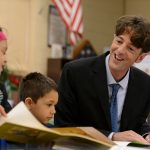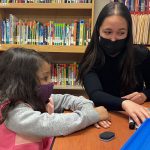The “Right to Read” bill that I sponsored went through a democratic process that began in the Joint Committee on Education in 2021. It was then the subject of a public hearing, during which members of the committee heard testimony from constituents across the state — who, by and large, were enthusiastically supportive. Among them were the dean of the UConn Neag School of Education, the president of the Connecticut State Colleges and Universities, urban superintendents, district-level curriculum professionals, classroom teachers, parents, literacy experts and researchers.
For a decade, researchers from the Neag School of Education have worked with the state on an ambitious literacy initiative designed to close Connecticut’s significant achievement gap. Their efforts have proved so successful that now a program that began with a few pilot schools is set for significant expansion to school districts of need across the state.
DIBELS itself doesn’t involve a lot of reading, but helps to predict how well children develop literacy skills by testing how fast and accurately they identify words, explained Rachael Gabriel, an associate professor of literacy education at the University of Connecticut.
Rachael Gabriel is associate professor of literacy education at UConn’s Neag School of Education. When large numbers of people showed up at legislative hearings in Connecticut, she became interested in their unusual engagement and strangely similar comments. Gabriel used critical discursive psychology, positioning theory, and narrative policy analysis to analyze the dyslexia law advocacy.
Devin Kearns, a reading disability researcher who’s been working with the education department on the new universal screening program, said the assessments can take as little as one minute to conduct to identify which skills young readers need extra support with.
This summer, UConn neuroscientist Fumiko Hoeft, education researcher Devin Kearns, and collaborators from Psychological Sciences, the Neag School of Education, Mathematics, Brain Imaging Research Center (BIRC), and others launched the five-week, all-expenses-included summer camp at Storrs for 3rd and 4th grade children who are struggling to read.
“Jack was known for many contributions to our field but especially his passionate commitment to our organization, his many talented doctoral students, and his innovative survey of trends in reading, the annual What’s Hot, What’s Not study. He was a friend to everyone in the literacy community and will be missed by us all. I will always remember his wide, welcoming smile each and every time we met.” —Donald J. Leu, University of Connecticut
Isabella “Bella” Gradante ’20 (ED), ’21 MA says she always knew she would pursue a career in education, having been raised by a family of educators and around schools her whole life. It wasn’t until she entered her master’s year in the Neag School’s Integrated Bachelor’s/Master’s (IB/M) program that she found what truly called her to the field: the practice of culturally relevant and sustaining teaching.
Julie M. Wood ’71 (ED), ’72 MA, a renowned educational consultant, decided to leave a planned gift to UConn to support research in an area close to her heart: children’s literacy. She has set up an endowment that will generate funding every year for a faculty member in the Neag School of Education to conduct research in effective practices to support children’s literacy development.
The good news is that significant research and data on how to effectively teach literacy already exist. In 2012, an initiative developed by the General Assembly’s Black and Puerto Rican Caucus studied best practices in early literacy and resulted in the “CT K-3 Literacy Initiative,” a pilot program with the UConn Neag School of Education that established school-wide improvement plans for reading and intensive interventions and provided ongoing literacy professional development.


